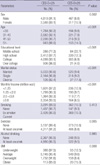1. Korean Ministry of Health and Welfare. Korean national health and nutritional examination survey. 2005. Seoul:
2. Kim NS, Moon OR, Kang JH, Lee SY, Jeong BG, Lee SJ, Yoon TH, Hwang KH, Kim N, Moon O, Kang J, Lee S, Jeong B, Lee S, Yoon T, Hwang K. Increasing prevalence of obesity related disease for koreans associated with overweight and obesity. Korean J Prev Med. 2001. 34:309–315.
3. Park JH, Yoon SJ, Lee HY, Cho HS, Lee JY, Eun SJ, Park JH, Kim Y, Kim YI, Shin YS. [Estimating the burden of psychiatric disorder in Korea]. J Prev Med Public Health. 2006. 39:39–45.
4. Jeong BG, Moon OR, Kim NS, Kang JH, Yoon TH, Lee SY, Lee SJ, Yoon T, Lee S, Lee S. Socioeconomic costs of obesity for korean adults. Korean J Prev Med. 2002. 35:1–12.
5. Van der Kooy K, van Hout H, Marwijk H, Marten H, Stehouwer C, Beekman A. Depression and the risk for cardiovascular diseases: systematic review and meta analysis. Int J Geriatr Psychiatry. 2007. 22:613–626.

6. Faith MS, Matz PE, Jorge MA. Obesity-depression associations in the population. J Psychosom Res. 2002. 53:935–942.

7. Stunkard AJ, Faith MS, Allison KC. Depression and obesity. Biol Psychiatry. 2003. 54:330–337.

8. Atlantis E, Baker M. Obesity effects on depression: systematic review of epidemiological studies. Int J Obes (Lond). 2008. 32:881–891.

9. Sachs-Ericsson N, Burns AB, Gordon KH, Eckel LA, Wonderlich SA, Crosby RD, Blazer DG. Body mass index and depressive symptoms in older adults: the moderating roles of race, sex, and socioeconomic status. Am J Geriatr Psychiatry. 2007. 15:815–825.

10. Kuriyama S, Koizumi Y, Matsuda-Ohmori K, Seki T, Shimazu T, Hozawa A, Awata S, Tsuji I. Obesity and depressive symptoms in elderly Japanese: the Tsurugaya Project. J Psychosom Res. 2006. 60:229–235.

11. Li ZB, Ho SY, Chan WM, Ho KS, Li MP, Leung GM, Lam TH. Obesity and depressive symptoms in Chinese elderly. Int J Geriatr Psychiatry. 2004. 19:68–74.
12. Dragan A, Akhtar-Danesh N. Relation between body mass index and depression: a structural equation modeling approach. BMC Med Res Methodol. 2007. 7:17.

13. World Health Organisation, International Association for the Study of Obesity, International Obesity TaskForce. The Asia-Pacific Perspective: Redefining obesity and its treatment. 2000. Sydney: Health Communications Melbourne.
14. WHO Expert Consultaion. Appropriate body-mass index for Asian populations and its implications for policy and intervention strategies. Lancet. 2004. 363:157–163.
15. Cho MJ, Kim KH. Diagnostic validity of the CES-D (Korean version) in the assessment of DSM-III-R major depression. J Korean Neuropsychiatr Assoc. 1993. 32:381–399.
16. Cho MJ, Kim KH. Use of the Center for Epidemiologic Studies Depression (CES-D) Scale in Korea. J Nerv Ment Dis. 1998. 186:304–310.

17. Dong C, Sanchez LE, Price RA. Relationship of obesity to depression: a family-based study. Int J Obes Relat Metab Disord. 2004. 28:790–795.

18. Cho MJ, Nam JJ, Suh GH. Prevalence of symptoms of depression in a nationwide sample of Korean adults. Psychiatry Res. 1998. 81:341–352.

19. Ohayon MM, Hong SC. Prevalence of major depressive disorder in the general population of South Korea. J Psychiatr Res. 2006. 40:30–36.

20. Crisp AH, McGuiness B. Jolly fat: relation between obesity and psychoneurosis in general population. Br Med J. 1976. 1:7–9.

21. Crisp AH, Queenan M, Sittampaln Y, Harris G. 'Jolly fat' revisited. J Psychosom Res. 1980. 24:233–241.

22. Onyike CU, Crum RM, Lee HB, Lyketsos CG, Eaton WW. Is obesity associated with major depression? Results from the Third National Health and Nutrition Examination Survey. Am J Epidemiol. 2003. 158:1139–1147.

23. Roberts RE, Deleger S, Strawbridge WJ, Kaplan GA. Prospective association between obesity and depression: evidence from the Alameda County Study. Int J Obes Relat Metab Disord. 2003. 27:514–521.

24. Cho JJ, Kim JY, Chang SJ, Fiedler N, Koh SB, Crabtree BF, Kang DM, Kim YK, Choi YH. Occupational stress and depression in Korean employees. Int Arch Occup Environ Health. 2008. 82:47–57.

25. Cole MG, Dendukuri N. Risk factors for depression among elderly community subjects: a systematic review and meta-analysis. Am J Psychiatry. 2003. 160:1147–1156.









 PDF
PDF ePub
ePub Citation
Citation Print
Print



 XML Download
XML Download